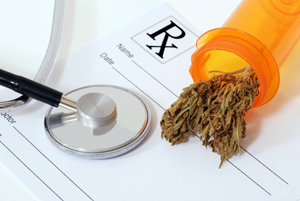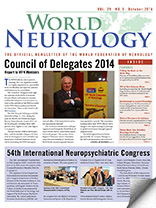What Do We Tell Our Patients?
 by Antoaneta J. Balabanov
by Antoaneta J. Balabanov
The idea to use cannabis plants to treat seizures is not new. From ancient China, through Babylonia and Palestine, Egypt and India, cannabis plants were used to treat many different maladies — among them seizures. Throughout the centuries, cannabis plants were considered magical by some and evil by others. This is not surprising given what is now known about the psychotropic properties of these formidable plants.
The interest of cannabis and their use for treatment of seizures has come in to the limelight in the recent years. Cases of epilepsy patients who have achieved seizure freedom using marijuana have been circulating on the Internet. Social networks have contributed by organizing interest groups and chat rooms to discuss this issue. The case of Charlotte, a child with Dravet syndrome who stopped having seizures after experiencing up to 50 seizures a day, ignited the epilepsy world when presented on CNN. Charlotte had failed all antiepileptic drugs (AED) available and when finally treated with cannabidiol (CBD), a component of marijuana, the effect was miraculous.
Our patients now know that medications based on cannabinoids are already being used for treatment of nausea, spasticity and pain. As epilepsy specialists, our patients ask us daily when medical marijuana will be available for use for treatment of seizures. Frequently, the following question is asked: “Why do I have to take medications with potential long-term side effects when I can use something more natural such as marijuana? If all medications that I have used have not help me stop having seizures, why can’t I try something that may potentially help my seizures without causing significant side effects?”
The patients are absolutely right to ask all these questions. Despite having 30 AEDs to use, about 30 percent of all patients with epilepsy are medically intractable. They continue to have seizures that eventfully cause cognitive, behavioral and psychiatric problems. Patients lose their jobs, their ability to drive, and to take care of their families. Stigma associated with epilepsy still exists, SUDEP is a real tragedy. In children, the effect of continued seizures on the developing brain could be devastating. Multiple studies have shown that children with uncontrolled seizures have a lower IQ later in life. Antiepileptic drugs, even when controlling the seizures, often cause side effects that interfere with the patient’s quality of life. The long-term safety profile is not known for most of the AEDs and that alone causes additional anxiety among patients and parents of children with epilepsy.
Is cannabis the solution that we have all been waiting for?
This is what we know: Cannabis sativa and Cannabis indica are two species of the Cannabis genus plant. Both plants produce multiple compounds called cannabinoids. Among them, two are of particular interest to us: tetrahydroxycannabiol (THC) and cannabidiol (CBD). These two cannabinoids were first isolated and characterized in the 1960s. THC has gained much more interest from the research world mostly because of its psychotropic properties causing significant cost to our society. CBD accounts for up to 40 percent of the plant’s extract and has none or very little psychoactive effects. CBD, however, has shown anticonvulsive properties when tested on animal epilepsy models. It is important to note that while the CBC anticonvulsant effect appeared to be promising in the acute models of seizures, there is less evidence that the effect is the same when tested on animal models of chronic epilepsy. The effect of seizure control in humans has not been studied well enough. There were only four randomized controlled trials (RCT), which were all done between 1978 and 1990. These studies included small number of patients (total of 48) who underwent a short length of treatment. Due to these and other methodological limitations, these clinical trials failed to provide evidence about the efficacy or safety of cannabinoids in patients with epilepsy.
Cannabis and its effect on seizure control on kids with epileptic encephalopathies has been one of the most discussed topics among patients’ families. There are no studies done so far, but there was a recent survey of 19 parents that is worthwhile to note. Twelve of the parents who responded to the survey have children with Dravet syndrome, one parent was with a child with Lennox-Gastaut Syndrome (LGS). All patients were treated with CBD enriched cannabis and products containing primarily CBD. The results reported by the parents were impressive — 53 percent of the parents reported 80 percent seizure reduction and 11 percent of the children were seizure free during the three-month trial. Among the 12 patients with Dravet syndrome, 42 percent reported more than 80 percent reduction in seizures. Serious side effects were not reported, only few parents noted drowsiness and fatigue. Most parents reported increased alertness. While these results are very impressive, they should be taken with caution since they are based solely on the parents’ reporting. In addition, the exact formulation of the different cannabis extract used by the parents is unclear.
The exact mechanism of action of the cannabinoids is not completely known. TSH was found to bind to two G-protein–coupled cell membrane receptors, named type 1 (CB1) and type 2 (CB2). CB1 receptors were found primarily in the brain, but also in several peripheral tissues (GI tract, adipose tissues, pancreas, muscle). CB2 receptors are mainly found in immune and hematopoietic cells. THC is the main psychoactive agent found in cannabis. CBD does not have psychoactive properties. This is perhaps because it does not activate CB1 and CB2 receptors. CBD reduces the psychoactive effects of THC; therefore it enhances its tolerability. CBD may supplement the antispastic effect of THC. This is because when used in combination, patients can tolerate higher doses of THC. Moreover, its anti-inflamatory, antioxidant and antiexcitotoxic mechanisms also contributes to the effect. The mechanisms by which CBC works as anticonvulsant are not entirely known. Different mechanisms of action have been proposed— most of them related to the reducing of neuronal excitabilities and neuronal transmission, while some others propose an anti-inflammatory effect. CBD is potentially involved in neuroinflamation by the reduction of new astrocyte production. This summary of the mechanism of action of the cannabinoids is incomplete, leaving behind many other molecular mechanism of action identified in animal models which are not clearly associated with any anticonvulsive effects, therefore, they will not be discussed here.
So, what do I tell my patients?
I tell them that I am as interested as they are in finding new therapies for epilepsy and if cannabis is proven to be “The New Therapy” I will be very eager to use it on all my medically intractable patients. However, I tell them that the scientific evidence for cannabis is lacking. I also try to point out that the reports circulating the web should be taken with great caution. These reports are mostly biased from the selection of the patients to the reported outcomes. In addition, every case of epilepsy is different and the disease is highly variable. I ask them not to base their decision to move to a state where medical marijuana is now legal based on anecdotal reports. I remind them to consider the fact that the marijuana growers follow no regulations and safety standards and that the products that they are offering often contains different percentages of CBC and THC among the 80 or more cannabinoids that the cannabis plants produce. Interactions between cannabis and currently used AEDs have not been studied, and are therefore unknown. Adding a new substance to an already very complex mix of medications can be dangerous, especially when it is not supervised in a medical setting. The concern of the long-term side effects of the AEDs is valid, but the long term effects of cannabis products on the brain should be considered as well. There have been reports on negative effects of cannabis on the developing brain. In adults, use of cannabis has been associated with worsening of executive function over time. Viewing cannabis use as a more natural way of treatment does not mean that cannabis effects should be taken lightly. AEDs that we use today have gone through years of studies and extensive testing before being approved by the FDA. There should be no reason for the cannabis product to be treated any differently.
My conversations with patients about seizures and medical marijuana will continue. As a physician, I support the idea that CBC should be studied for its possible anti-convulsive properties. I do not support legalization of marijuana, but I also realize that current status of medical marijuana as a Federal DEA Schedule 1 controlled substance stands in the way of medical research that needs to be done, so I can give my patients more definite answers. Until this happens, I will continue with my mantra: randomized double blinded placebo-controlled studies are needed to determine the efficacy and safety of CBD and other cannabinoids as potential treatments of epilepsy.
